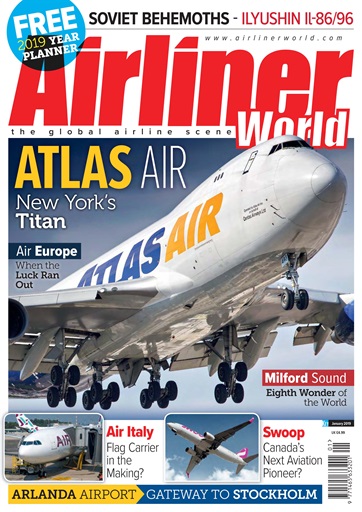The January edition of Airliner World is on sale now, including a FREE 2019 Year Planner, plus…
Almost a year after its launch, we reflect on the colourful history of Air Italy, before joining the airline on its inaugural service from Milan/Malpensa to New York/JFK.
With flag carrier Alitalia in a perennial coma-like state – which even the deep pockets of Etihad couldn’t revive – and regional air travel dominated by foreign low-cost carriers, launching a new full-service carrier in Italy could appear questionable. Despite these strong headwinds, nearly a year after its first commercial services, Air Italy is an airline which is looking to the future with cautious optimism – could we be seeing a new national airline in the making?

(Photo: AvStock / Mikko Heiskanen)
Across the pond, a very different kind of airline is also making waves – Atlas Air. New York’s titan may have come from humble beginnings, but today its business model represents diversified flexibility as an ACMI supplier, with Crew, Maintenance and Insurance (CMI), aircraft leasing and cargo and passenger charters. Its customers are shippers, freight forwarders, airlines, express operators, integrators, sporting groups and the U.S. military. Away from the global airfreight industry, Atlas is the world’s largest ACMI provider.
Airliner World recently sat down with Atlas Air’s president and CEO William J Flynn to find out the secrets behind the carrier’s success.

(Photo: Atlas Air)
North of the border, WestJet’s plucky new budget subsidiary Swoop aims to revolutionise the way Canadians (and even some Americans) travel.
In the fiercely competitive ultra low-cost carrier game, two variables factor into the success of any operation: population size and the geographical spread of potential passengers. When applying this metric, Canada can appear to be a woefully unattractive proposition for budget carriers that have traditionally thrived in high-density markets such as western Europe and the Far East.
One airline crunching the numbers and giving the concept a go is Calgary-based Swoop. A wholly-owned subsidiary of the venerable WestJet, the company launched commercial operations in June 2018 and is designed to fill the gap left as its parent moves towards the mainstream market.

(Photo: Swoop)
Continuing our airline coverage, we turn the clock back almost three decades to recount the history of Air Europe, the humble British leisure carrier whose global ambitions ultimately led to catastrophic failure.
This is the story of a holiday airline based just outside London whose untimely demise was – at least partly – blamed on tensions in the Middle East. The resulting failure wrecked the travel plans of thousands, rocked the travel trade and resulted in calls for government to rethink the financial protections available to airline passengers.

(Photo: AvStock / Richard Parkhouse)
Were it not for the lack of pastel-coloured liveries and flamboyant uniforms, Airliner World regulars could be forgiven for reading the above and thinking this forms part two on the collapse of Court Line, a fiasco which caused embarrassment to both the government and the travel industry in the 1970s. In fact, we’re looking back at the 1990s and, officially at least, lessons have been learned. Surely Air Europe couldn’t be another example of a leisure airline with big ideas flying too close to the sun?
Aviation enthusiasts arriving at Mactan Cebu International Airport can’t fail but notice SEair International’s Boeing 737-200. The aircraft in question, RP-C4737 (c/n 23065), is one of almost 1,100 examples of the -200 series built by the US manufacturer between 1967 and 1988. But while many of its stablemates have long since retired, this particular 737 is no museum piece. By day it sits parked up on the ramp, looking rather forlorn under the hot Filipino sun. It becomes a different kind of beast entirely once the sun goes down, earning its crust carrying cargo across the Philippines.
We hop into the jump seat and join the ‘freight dogs’ on their nocturnal mission.

(Photo: Dirk Grothe)
Maintaining this semi-historic theme, we profile the Soviet Union’s first – and so far only – widebody airliner family, the Ilyushin Il-86/96.
The ’jet age’ boom in Soviet skies meant that by the end of the 1960s, airways were becoming congested. Aircraft had to queue to take off, while others circled in holding patterns waiting to land. Similar problems in the West led in the early 1970s to the introduction of the first widebody jets, beginning with the Boeing 747 which entered service with Pan Am, quickly followed by the McDonnell Douglas DC-10, the Lockheed L-1011 TriStar and the Airbus A300.
Mirroring events in the West, the design bureau of the Soviet Union set out to create its own people mover that would not only reduce the number of movements needed on busy routes, but also reduce cost per seat with improved fuel efficiency and lower operating costs, enabling even more people to fly at an affordable price.
The result was the Il-86, a type that transformed the aviation industry behind the Iron Curtain but whose fortunes were intrinsically linked to that of its home nation.

(Photo: Transport-Photo Images)
‘We catch our first view of the 2,500ft airstrip in the distance, sitting on a convenient piece of flat land amid towering, forested mountainsides and sheer cliff faces. A Cessna is also visible ahead of us, positioning downwind left hand for a landing on Runway 29.
“With our starboard wing tip seemingly skirting just feet from the rockface, Captain Jim Rooney makes a tight curving circuit to follow the Cessna. He has to work even harder now, combining commentary to his awe-inspired passengers with a close eye on those steep craggy rocks, while ensuring that the aircraft’s speed and altitude are consistent with a touch down ‘on the numbers’. He’s also well aware there is another Milford inbound just behind us, following our every twist and turn. We continue the descent onto final approach with a steep bank and then, just moments after lining up with the runway, we swoop over the threshold for a smooth touchdown…’
Queenstown, in the heart of New Zealand’s South Island, offers visitors an opportunity for fun, thrills, adventures or simply a pleasant place in which to relax. Set amid the stunning Southern Alps on the shores of Lake Wakatipu, the nation’s ‘adventure capital’ as it is often dubbed, is a haven for thrill-seekers taking to paragliding, bungee jumping or other daredevil pastimes. But for those with more sedate inclinations, a day trip from Queenstown to Milford Sound by air is thoroughly recommended, delivering a jaw-dropping experience that can be undertaken for a relatively modest outlay.

(Photo: Tony Merton Jones)
Meanwhile, back in Europe the Swedish are renowned for their stylish yet functional designs. At the nation’s largest airport, Arlanda, this ‘form and function’ hasn’t always been apparent, but over recent years the facility has been gradually improved and is now a model of efficiency.
That’s’ not to say Stockholm’s primary gateway isn’t facing challenges.
“If you look at the figures today, we’re already at 27 million passengers, Arlanda’s business aviation director Elizabeth Axtelius told Airliner World. “And now we have the next expansion phase coming. But we have also started to look at the long-term expansion, out until 2070, when we are forecasting we will be handling around 70 million passengers per year. So, we are looking at what infrastructure we will require to manage such numbers of people as well as planning for a third runway.
“Although this isn’t a near-term problem, we will have to take the necessary action to gain environmental permits, etc before construction work can start. We also must take a wider perspective, looking at the development of supporting facilities including the construction of an airport city and cargo handling amenities. So, we have to have a long-term plan to make sure that everything is developed in the right place.”

(Photo: Swedavia / Daniel Asplund)
Our packed January edition concludes with our regular comprehensive coverage of worldwide news, including a report from the official opening of Istanbul’s new airport, plus Air Astana outlines plans to launch a low-cost subsidiary, Icelandair moves to acquire WOW air, Bombardier offloads its Q400 programme and the Airbus A330-800 completes its maiden flight. We also have all our regular sections covering the latest commercial aircraft acquisitions, up-to-date accident reports and developments from the world of aviation training and MROs, and we give you the chance to win a year’s subscription in our caption competition.
Get your copy now from www.airlinerworld.com

